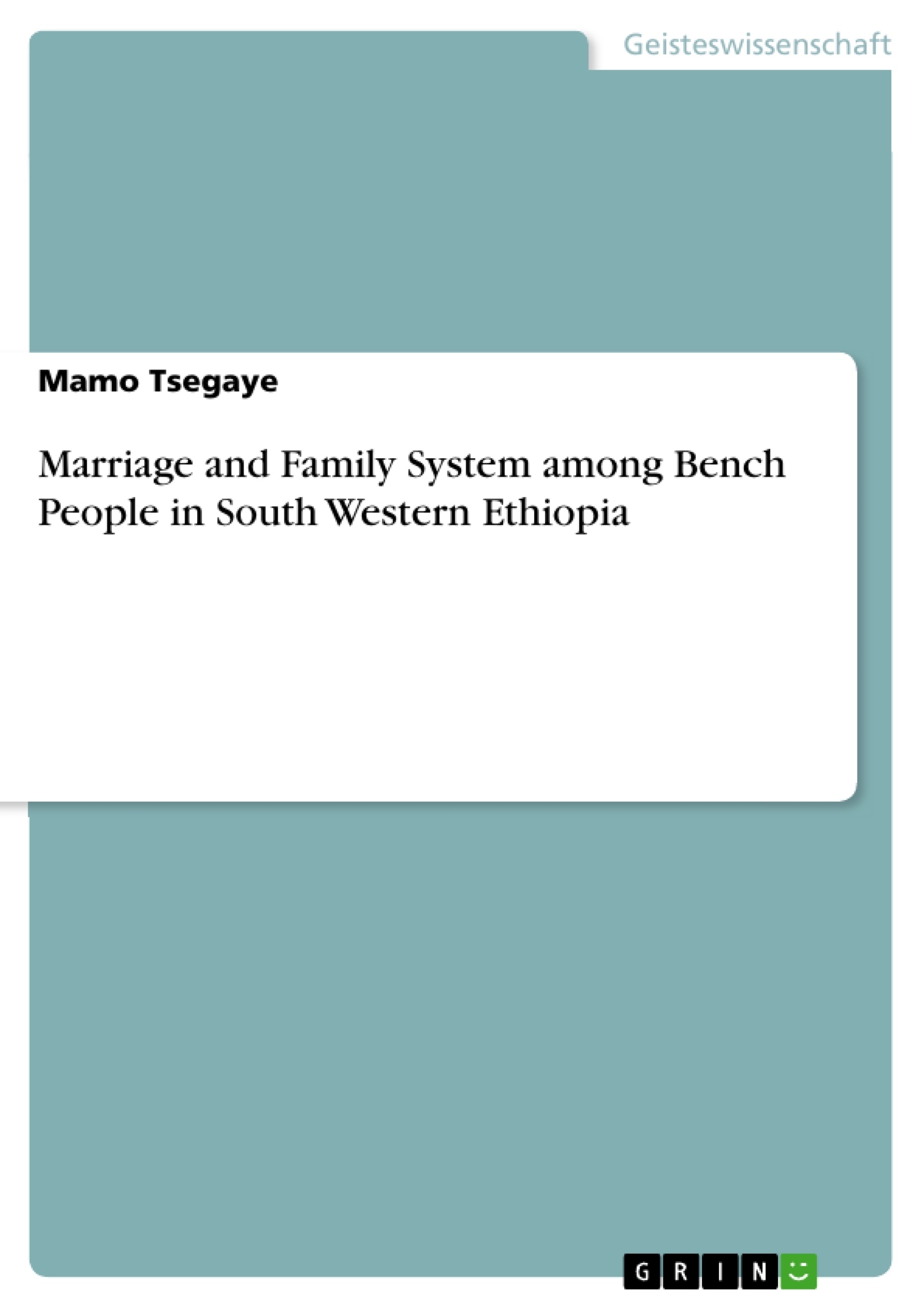The overall objective of this study is to investigate the marriage practice and family system in Bench people. Ethiopia is a multi-ethnic country with over eighty-five different ethnic groups and diverse cultural traits scattered throughout the country. Each ethnic group has their own cultural beliefs and practices that play a dominant role in shaping the behavior and action of its members. Bench people, as any other societies in Ethiopia, have their own forms of marriage and family system based on their culture. Families exist in all societies and they are part of what makes us human. However, societies around the world demonstrate tremendous variation in cultural understandings of family and marriage. Ideas about how people are related to each other, what kind of marriage would be ideal, when people should have children, who should care for children, and many other family related matters differ cross-culturally. Therefore, this study attempts to assess the marriage and family practices among Bench people.
This study has both thematic and geographical delimitations depending on budget and scope of the study. Thematically, it assessed customary marriage practices of Bench people, types of marriage, kinds of marriage payment, the role marriage and family in the Bench people.
Geographically, the study is delimited to Bench sheko zone, in SNNPR on the selected two kebeles namely Shasheqa and Hibret. The target group of the study (interview) is selected from both the rural and urban places which incorporated different areas engaged in marriage and also who are not engaged of males and females. It will focus on identification of the marriage and family aspects of the Bench community.
Inhaltsverzeichnis
- I. INTRODUCTION.
- 1.1. Background of the Study..
- 1.2. Statement of the Problem…...
- 1.3. Objectives of the study..
- 1.3.1. General Objective
- 1.3.2. Specific Objectives
- 1.4. Research Questions......
- 1.5. Scope of the Study
- 1.6. Significance of the Study.
- II. LITERATURE REVIEW.
- 2.1. General Overview of marriage..........\li>
- 2.2. General overview of family
- III. THE RESEARCH METHODOLOGY.
- 3.1. The Research Design
- 3.2. Research Approach.
- 3.3. The Study Area.
- 3.4. Population of the Study...
- 3.5.Data Sources
- 3.6. Tools of Data Collection..
- 3.7. Ethical considerations
- 3.8. Data analysis and interpretation......
- IV. TIME AND BUDGET BREAK DOWN..
- 4.1. Time break down
- 4.2. Budget break down.
- V. REFERNCES...
Zielsetzung und Themenschwerpunkte
Diese Forschungsarbeit zielt darauf ab, die Ehe- und Familiensysteme der Bench-Bevölkerung in Südwestäthiopien zu untersuchen. Das Hauptziel ist es, ein umfassendes Verständnis der traditionellen Ehepraktiken, der verschiedenen Familienformen, der Rolle der Ehe und Familie in der Gesellschaft sowie der sozioökonomischen Bedeutung dieser Institutionen zu gewinnen.
- Traditionelle Ehepraktiken der Bench-Bevölkerung
- Verschiedene Familienformen in der Bench-Gesellschaft
- Die Rolle der Ehe und Familie in der Bench-Gesellschaft
- Sozioökonomische Bedeutung von Ehe und Familie
- Ehe und Familie in Bezug auf die soziokulturellen Strukturen und Traditionen der Bench
Zusammenfassung der Kapitel
- Kapitel I: Einführung: Dieses Kapitel liefert einen Hintergrund für die Studie und definiert den Themenbereich. Es beleuchtet die Bedeutung der Ehe und Familie in verschiedenen Gesellschaften und die Notwendigkeit, die spezifischen Praktiken der Bench-Bevölkerung zu untersuchen. Es werden auch die Forschungsziele, die Forschungsfragen und der Umfang der Studie vorgestellt.
- Kapitel II: Literaturüberblick: In diesem Kapitel wird ein Überblick über die bestehende Literatur zu Ehe und Familie gegeben. Es werden verschiedene Perspektiven auf die Ehe und Familie und deren Bedeutung in verschiedenen Gesellschaften beleuchtet. Dieser Überblick soll einen theoretischen Rahmen für die Studie liefern.
- Kapitel III: Forschungsmethodik: Dieses Kapitel erläutert die Forschungsmethodik, die für die Untersuchung verwendet wird. Es beschreibt die Forschungsstrategie, die Datenerhebungsmethoden und die Analysetechniken, die angewendet werden, um die Forschungsfragen zu beantworten.
Schlüsselwörter
Die Forschungsarbeit konzentriert sich auf die Themen Ehe, Familie, Ethnologie, Kultur, soziale Strukturen, sozioökonomische Faktoren und die Bench-Gesellschaft in Südwestäthiopien.
- Quote paper
- Mamo Tsegaye (Author), 2019, Marriage and Family System among Bench People in South Western Ethiopia, Munich, GRIN Verlag, https://www.grin.com/document/1164850



